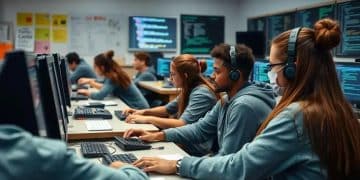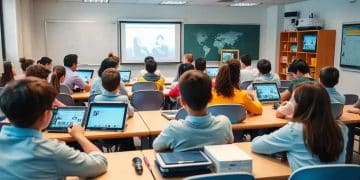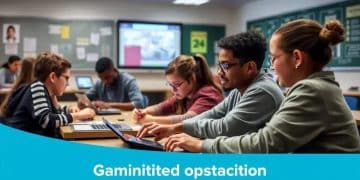Remote learning platforms trends shaping education today

Remote learning platforms are evolving through technologies like AI and gamification, enhancing personalization and engagement while integrating hybrid models that combine online and in-person education for greater flexibility and effectiveness.
Remote learning platforms trends are rapidly changing how students and educators interact. Have you ever wondered how these platforms are revolutionizing education? Let’s dive into the latest trends and their potential impact.
Emerging technologies in remote learning
Emerging technologies in remote learning are transforming how education is delivered around the world. New tools and platforms are being introduced to enhance the online learning experience.
These technologies are providing innovative solutions to traditional learning challenges. For instance, artificial intelligence is being utilized to personalize education. By analyzing student data, AI systems can tailor lessons to fit individual learning styles, helping students engage more effectively.
Key Technologies Influencing Remote Learning
Several key technologies are making a significant impact:
- Augmented Reality (AR): AR brings immersive experiences into the virtual classroom.
- Virtual Reality (VR): VR offers students realistic simulations, making learning interactive.
- Blockchain: This technology ensures secure record-keeping of achievements and credentials.
- Cloud Computing: It enables easy access to resources and collaboration among students and teachers.
Another crucial aspect is the use of learning management systems (LMS). These platforms streamline course delivery and management, making it easier for educators to monitor student progress.
Additionally, tools like video conferencing applications have made face-to-face interaction possible, allowing real-time feedback and collaboration. This is crucial for maintaining a sense of community among remote learners.
The Future of Remote Learning Technologies
Looking ahead, emerging technologies will continue to evolve. The integration of machine learning will further enhance adaptive learning platforms, ensuring that all students receive the support they need to succeed.
Moreover, innovative partnerships between tech companies and educational institutions will lead to more effective solutions. As these technologies advance, they will redefine the landscape of education, making learning more accessible and engaging for everyone.
The impact of social interaction on online education
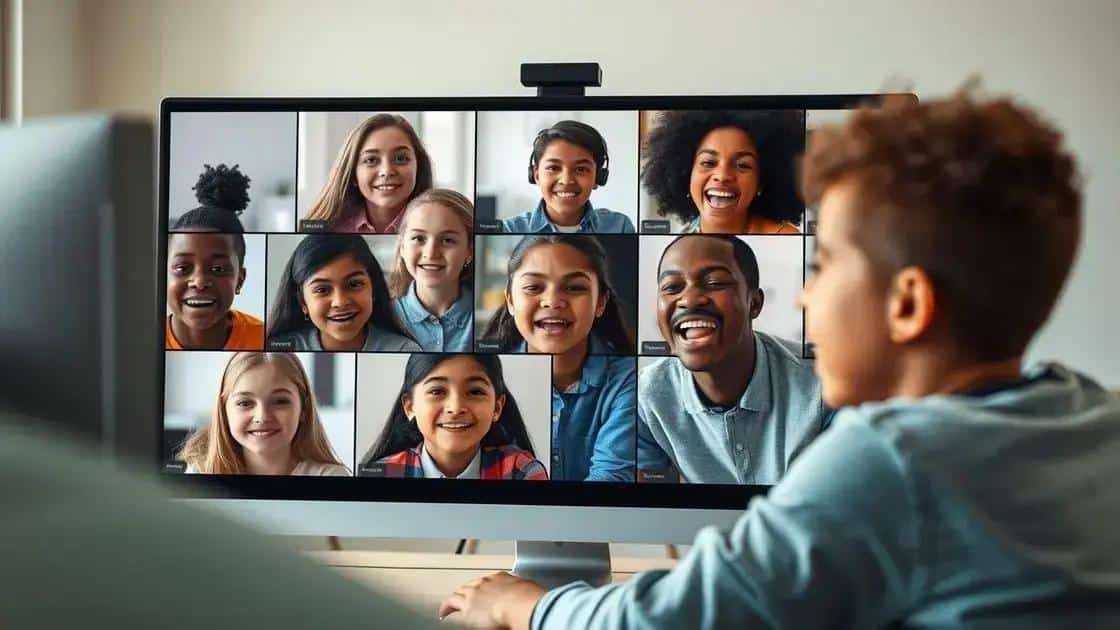
The impact of social interaction on online education is profound. As students navigate remote learning, their connections with peers and instructors significantly affect their academic success and overall experience.
In the online environment, having opportunities for interaction can enhance motivation and engagement. Virtual discussions, group projects, and forums help create a sense of community. When students are involved in engaging activities, they are more likely to stay focused and perform better academically.
Benefits of Social Interaction in Online Education
Several benefits emerge from fostering social interaction:
- Increased Engagement: Active participation leads to higher levels of interest in course material.
- Peer Support: Students can collaborate, share resources, and help each other overcome challenges.
- Improved Communication Skills: Regular interaction hones students’ abilities to express ideas clearly.
- Emotional Well-being: A sense of belonging can reduce feelings of isolation.
Another aspect is the role of instructors in facilitating social interaction. Online educators must create opportunities for discussions and group activities. By encouraging dialogue, teachers can help students feel more connected and valued.
Moreover, utilizing technology to support social interaction is crucial. Platforms that allow video calls or instant messaging can foster real-time communication. These tools bridge the gap between students, making online learning not just about content delivery but also about building relationships.
Strategies to Enhance Social Interaction
To improve social interactions in online learning, consider these strategies:
- Regular check-ins: Schedule one-on-one sessions with students to discuss progress.
- Interactive assignments: Design projects that require collaboration.
- Discussion forums: Encourage students to engage in moderated discussions on relevant topics.
- Group workshops: Create opportunities for peer-led sessions.
Social interaction plays a vital role in shaping the online education experience. By placing emphasis on connection and collaboration, educators can foster a deeper learning environment. Such efforts can lead to more successful, satisfied learners who feel part of a larger community.
Trends in student engagement strategies
Trends in student engagement strategies are crucial as educators adapt to the evolving landscape of online learning. Engaging students in a virtual environment presents unique challenges, but innovative strategies can foster participation and motivation.
One major trend is incorporating gamification into lessons. By applying game-like elements, such as point systems and challenges, teachers can make learning more interactive and fun. This approach encourages students to participate actively and reinforces the material in an enjoyable way.
Active Learning Techniques
Active learning techniques are another pivotal strategy to enhance engagement. These methods immerse students in the learning process, prompting them to take part actively. Key techniques include:
- Group Discussions: Foster communication and collaborative learning among peers.
- Peer Teaching: Allow students to teach each other concepts, reinforcing their understanding.
- Problem-Based Learning: Encourage learners to solve real-world problems, making lessons relevant.
- Interactive Quizzes: Use tools to create live quizzes, making assessment fun and engaging.
Additionally, personalized learning paths are gaining popularity. Students can progress at their own pace, choosing topics that interest them. This autonomy allows for tailored educational experiences, catering to diverse learning needs.
Technology plays a vital role in these trends. Learning management systems now offer features that support collaboration. This includes discussion forums and breakout rooms, where students can engage more deeply with their classmates and instructors.
Incorporating Feedback
Regular feedback is essential in keeping students engaged. By offering timely insights into their performance, educators can guide students on what to improve. This feedback can come through surveys, rubric-based assessments, and one-on-one meetings.
Moreover, leveraging multimedia content helps break the monotony of traditional lectures. Videos, podcasts, and interactive presentations create varied learning experiences that cater to different learning styles.
In summary, implementing these student engagement strategies can vastly improve participation and motivation in online courses. As education continues to evolve, staying updated on these trends equips educators to create enriching learning environments that inspire students.
Future outlook for remote learning platforms
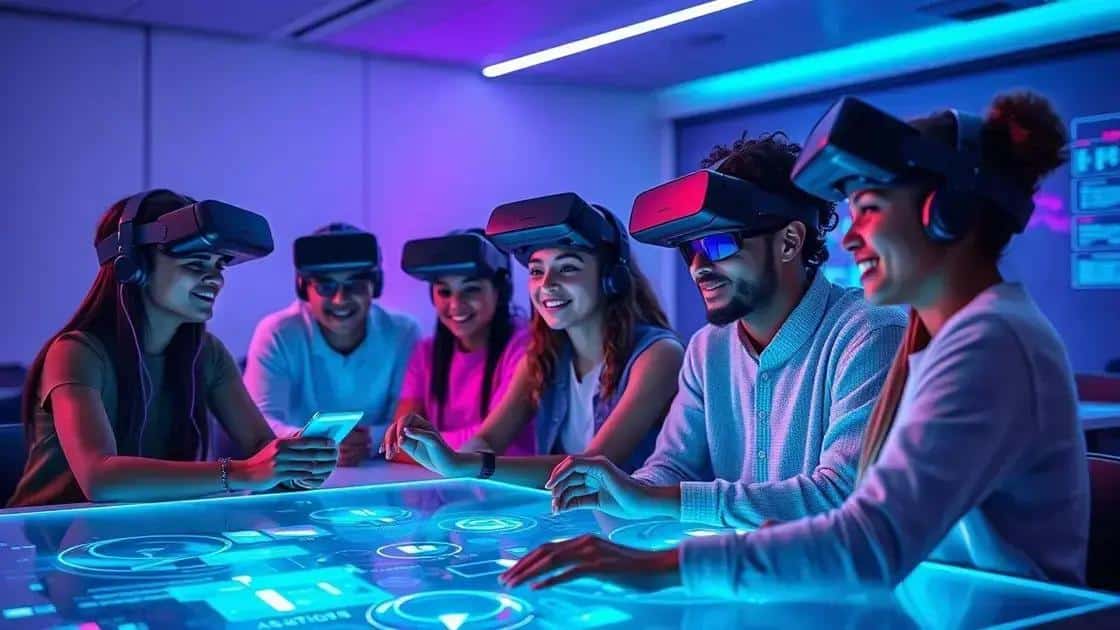
The future outlook for remote learning platforms is bright and full of potential. As technology evolves, so does the way education is delivered. Many exciting developments are on the horizon that can enhance learning experiences for students globally.
One significant trend is the increasing integration of artificial intelligence (AI) in educational platforms. AI can personalize learning by adapting content to meet individual needs. This technology helps identify areas where students struggle and provides tailored resources, making the learning process more efficient.
Enhancements in User Experience
User experience is crucial for any online platform. The future will see more intuitive interfaces that make navigation easier for students and educators alike. Features like voice recognition, natural language processing, and chatbots will streamline communication and support.
- Personalized Dashboards: Users can track their progress and find resources that are relevant to them.
- Interactive Content: Engaging videos and quizzes will be used to reinforce learning.
- Virtual Reality (VR): Immersive learning environments will allow students to experience subjects in new, interactive ways.
Moreover, the shift towards hybrid learning models combines both online and in-person education. Schools and universities are exploring how they can effectively merge these two formats. This model allows for flexibility in learning, catering to the diverse needs of students.
Collaboration and Community Building
Another key aspect is the emphasis on collaboration and community. As remote learning becomes more common, fostering connections among students is essential. Platforms are introducing features that enable group work, discussions, and peer support.
Furthermore, the future will likely see institutions partnering with technology companies to continuously innovate education. These partnerships can lead to the development of new tools that enhance engagement and improve learning outcomes.
The role of data analytics will also grow. By analyzing student performance data, educators can make informed decisions about course adjustments and teaching methods. This analytical approach ensures that the learning experience is continuously refined and improved.
FAQ – Frequently Asked Questions about Remote Learning Platforms
What is the role of AI in remote learning?
AI personalizes learning by adapting content to individual student needs, helping to identify areas for improvement.
How does gamification enhance student engagement?
Gamification introduces game-like elements into learning, making it more interactive and motivating for students.
What does hybrid learning mean?
Hybrid learning combines online education with in-person classes, providing flexibility and accommodating different learning styles.
Why is social interaction important in online learning?
Social interaction fosters a sense of community, encourages collaboration, and helps reduce feelings of isolation among students.

